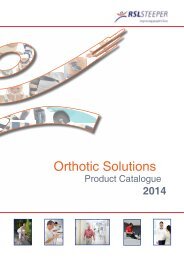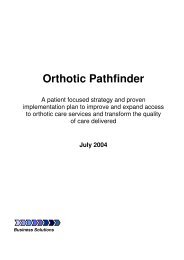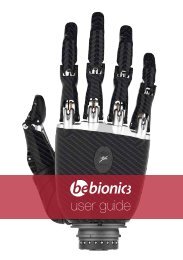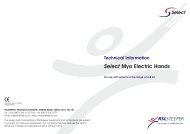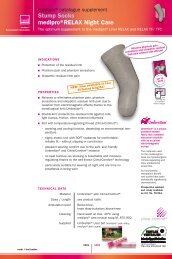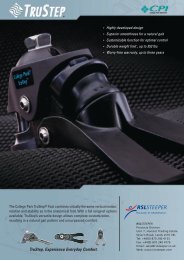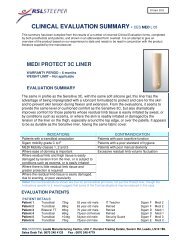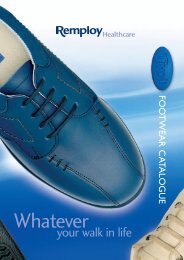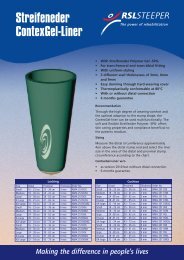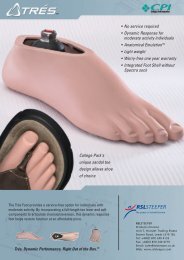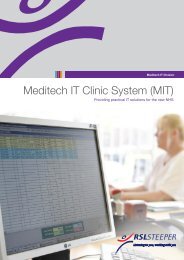CLINICAL EVALUATION SUMMARY - CES MED K 03 - R S L Steeper
CLINICAL EVALUATION SUMMARY - CES MED K 03 - R S L Steeper
CLINICAL EVALUATION SUMMARY - CES MED K 03 - R S L Steeper
Create successful ePaper yourself
Turn your PDF publications into a flip-book with our unique Google optimized e-Paper software.
<strong>EVALUATION</strong> RESULTS<br />
CURRENT PRESCRIPTION<br />
Patient 1 Laminate Quad socket Tran femoral Locking liner, KFM1 knee, Tribute Foot<br />
Patient 2 (First prosthesis) Laminate Quad socket, NOHP3 knee, Axia foot<br />
Patient 3 Medi AKOS liner on a polypropylene socket with Medi Imatik knee and CPI Trustep<br />
Patient 4 No previous/current prescription.<br />
Patient 5 No previous/current prescription<br />
Patient 6 No previous/current prescription<br />
PROSTHETIST’S COMMENTS<br />
Patient 1 – Due to increased mobility the primary prescription was no longer appropriate. Upon supply of the<br />
changed prescription additional physiotherapy support was provided. He adjusted excellently to his knee reporting<br />
that it felt smooth. His gait improved dramatically and he achieved symmetry in swing phase. The pneumatic<br />
cylinder proved easy to adjust to achieve optimum swing, with small alterations resulting in greater changes than<br />
would normally be expected from a pneumatic cylinder.<br />
Patient 2 – This gent became an amputee as a result of RTA prior to which he had been an active and healthy<br />
individual. This knee was prescribed because this gent appeared to fill all of the manufacturers recommended<br />
criteria. It was anticipated that this gent would be suited to the benefits of fine adjustment afforded by a hydraulic<br />
cylinder. This cylinder has proven to be adequate for this gent’s gait. He walked at a varied cadence and the<br />
cylinder could be adjusted to accommodate this with small adjustments. Swing phase is very smooth in<br />
appearance.<br />
Patient 3 – Previously prescribed Endolite IP+ and OrthoEurope Sensor knees the patient liked the speed change<br />
feature of the IP+, steps descent feature of the Sensor though neither knee achieved what he felt he needed. He’d<br />
previously benefited from the pre-launch version of the Imatik knee, so an NOHP3 loaner unit was fitted in its<br />
place. As the Imatik and the NOHP3 share the same chassis design the Prosthetist thought it would be a good<br />
opportunity to check which particular feature of the Imatik he’d benefited from most.<br />
Patient 4 – This lady did not initially receive sufficient physiotherapy to achieve her full potential and so progress<br />
post amputation was hampered. The Prosthetist noted that the knee was easy to set up, silent in operation and<br />
that there was a good angle of knee flexion. Since fitting the knee no adjustments or maintenance have been<br />
required.<br />
Patient 5 – This knee had been applied to a primary amputee requiring gait training. The patient had had difficulty<br />
in loading the forefoot in order to release the knee and found this difficult when away from the walking gym<br />
environment. He fell on a number of occasions and his prescription was reviewed. The knee was an inappropriate<br />
prescription for this gentleman even though the knee functioned well when used during gait training.<br />
Patient 6 – This was the first prescription for this patient. No maintenance or further adjustment was required after<br />
initial provision. A possible need for a specific cosmesis that will “accommodate the change in dimension of the<br />
knee during swing without effecting function” was identified. This has continued to be a successful prescription for<br />
this patient who has progressed well with her rehabilitation.<br />
PATIENT’S COMMENTS<br />
Patient 1 – The patient reported that he found this knee a considerable improvement on his previous prescription.<br />
He reported that it took him a little while to adjust to. He felt that the knee action was smooth and that he had<br />
gained some freedom in mobility with this knee. He reported that the design of the knee allowed him to kneel more<br />
comfortably and he felt more stable.<br />
Patient 2 – This patient reported that he found wearing a prosthesis easier than he expected and that the “knee<br />
felt good”. He did however add that he was unable to be objective with his comments because he had no point of<br />
reference. (This was this gent’s first prosthetic prescription). He also reported that the knee felt “smooth” and “easy<br />
to walk with”.<br />
Patient 3 – Though it took time for the patient to get used to the polycentric Imatik knee, he persevered with it, due<br />
to liking the “immediate and smooth change in function as he increased his speed”. He found ascending hills<br />
easier, (probably due to the effective shortening at mid swing).The change to the NOHP3 was simple and though<br />
he noticed the fact that the pspc wasn’t able to cover the full range of speeds he could achieve with the Imatik, it<br />
was still smooth in its action and just as effective in every other way.<br />
Patient 4 – Being a Primary amputee this patient had no other prosthetic experience to compare the knees<br />
performance with – however the patient stated that she felt stable and secure and was generally pleased with her<br />
prosthesis as a whole.<br />
Patient 5 – The patient noted that he had difficulty getting into his car because he was unable to unlock the knee.<br />
Patient 6 – The patient recorded that she was happy with the function and performance of the knee. She continues<br />
to lead a full and active life.



